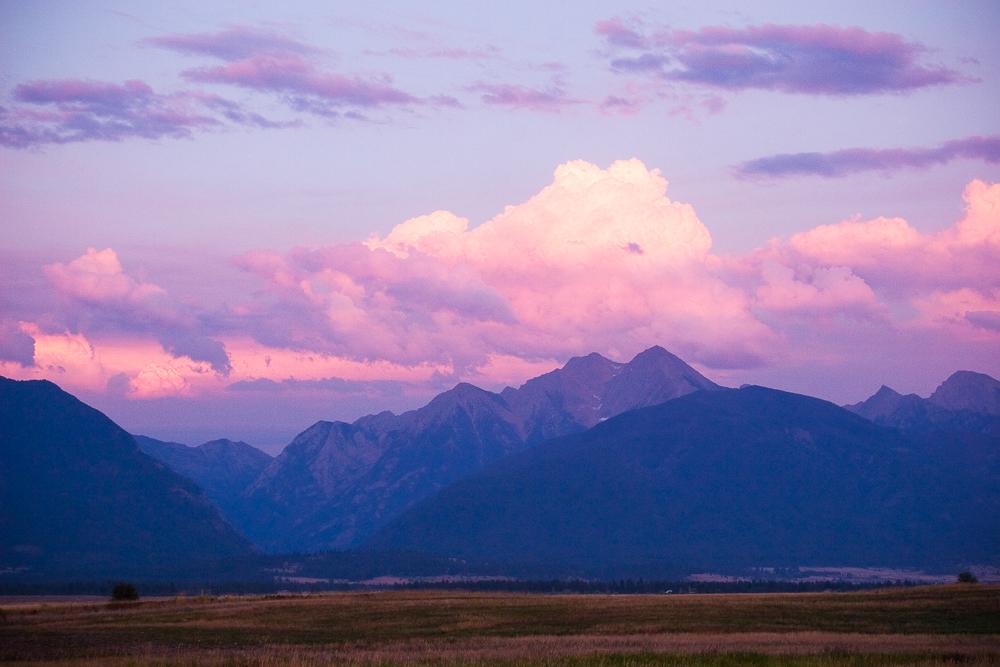Finding Spirit

Mission Mountains Sunset, Flathead Reservation, 2007 by Sue Reynolds
No single view of nature existed or exists among the hundreds of Native American tribes in the United States, but common beliefs and practices regarding nature’s land and animals include appreciation, respect and reverence. To many American Indians, religion is found and practiced in nature. The understanding that a Creator made the earth and exists in living things and throughout the natural world is widespread and has guided Native Americans to live in and with nature responsibly and to take from Mother Earth only what was needed.
More on Lakota people's reverence for the land
Today, American Indian people continue to live in reciprocity with their homelands. Yet the complexities of contemporary life, including opportunities for much needed revenue from natural resources, as well as conflicting tribal and non-Indian interests complicate this issue.
View related video: Walking Between Two Worlds: Native Pride and Life
Photographer Sue Reynolds respects that Native Americans are rooted in the land and believes that Spirit is everywhere. She experiences strong connections to reservation lands and feels they are sacred, much like the Episcopal church where she worships. Artist’s Statement
Elicit students’ responses to Reynolds’ landscape photograph using one or more of the Interpretation Strategies - See an inquiry approach to all Everyday Native photographs.
Discussion/Writing Questions
|
American Indian traditional beliefs consider nature to be a place where Spirit lives. A Yupiaq from Alaska, Angayuqaq Oscar Kawagley, writes, “The Yupiaq people live in an aware world. Wherever they go they are amongst spirits of their ancestors, as well as those of the animals, plants, hills, winds, lakes and rivers.”
Native American tribes have designated certain places in their homelands such as mountains, rivers, and other natural things important to their beliefs as sacred, just as you might a church, synagogue, temple, holy book, or religious object such as a Christian cross or sculpture. What makes a place sacred? How does the Native American practice of living with and in nature with reverence relate to your behavior and practices when you and your family are in your place of worship?
Victor Charlo’s poem “Dixon August Sky” expresses what he sees and loves in nature.
Click here to view poem full screen
Dixon August Sky
Rainbow fills the sky with those light pastels
I love so much, red, gray, orange hues so soft
Over Red Sleep Mountain waiting
To find their place on the horizon.
Red Sleep Mountain within the boundaries
Of the National Bison Range, good for a name,
But then there are the Salish Mountains
North of the Bison Range. How is that for a name
All in one place, right from my back room?
I see Red Sleep Mountain.
I am the Salish Mountains.
Dirty Corner Poems and Other Stories, by Victor A. Charlo. Available on Amazon.
Just as photographers do, poets construct their poems to communicate their ideas. They choose words, flow and pauses carefully to help convey their thoughts. These excerpts from the Poet's Statement give insights into the way Victor Charlo writes and what he chooses to write about:
"I was born and raised on the Flathead Reservation and write poems about reservation life, family and friends I love, loss, nature..."
"These early experiences are why I write the way I do—with as few words as possible. I cut to the quick. When I write I try to conjure up the old sayings, those words I grew up with that come out every now and then."
American Indians believe there is Spirit in living things. In this photograph we can see Quinton’s deep connection to this horse. Horses have played an important part in many American Indian cultures and histories, including those of the Blackfeet, Crow and Lakota, having transformed their hunting, defense and transportation. The adoption of horses into Native American life included skill, discipline, concern and care and represented an important aspect of individual and tribal pride and wealth. The role of horses in Blackfeet religion and healing was and continues to be an important “medicine” for this tribe.
Elicit students’ responses to this photograph using one or more of the Interpretation Strategies
Discussion and Writing Questions
|
The man holding the rock is Emmett Martin from Mobridge, South Dakota, across the Missouri River from the Standing Rock Reservation where he grew up. Like many Lakota, he was raised speaking their indigenous language and understanding that all of the elements in the land contain Spirit and hold stories of who travelled and what happened there.
Discussion and Writing Questions
|
Other ResourcesLakota Origin Story by Elder Duane Hollow Horn Bear by The WoLakota Project. YouTube. I Will Be Meat for My Salish, by The Montana Writers Project and the Buffalo of the Flathead Indian Reservation. Available on Amazon. |
Click here to access our extensive library of related websites, readings, videos, and more.
